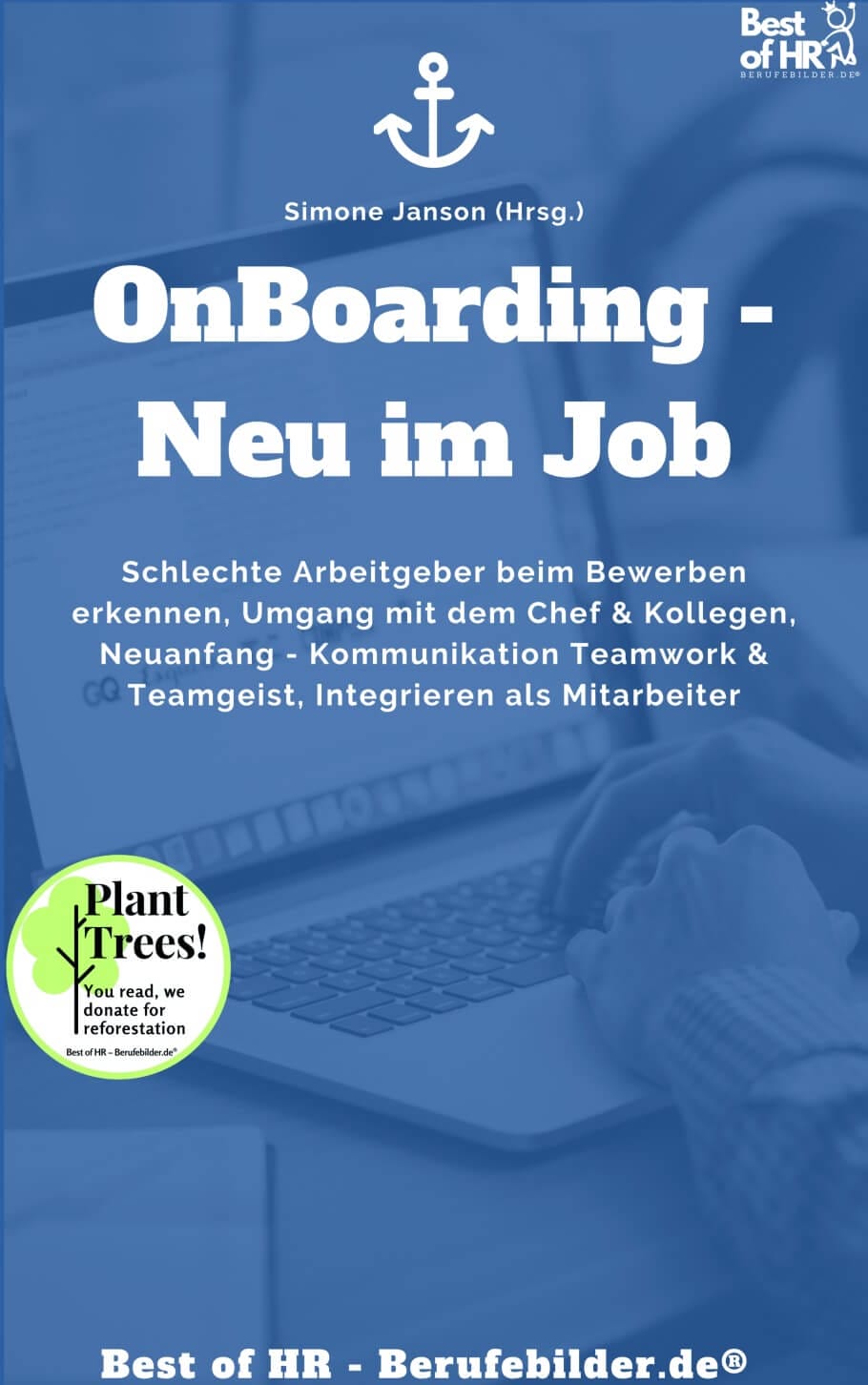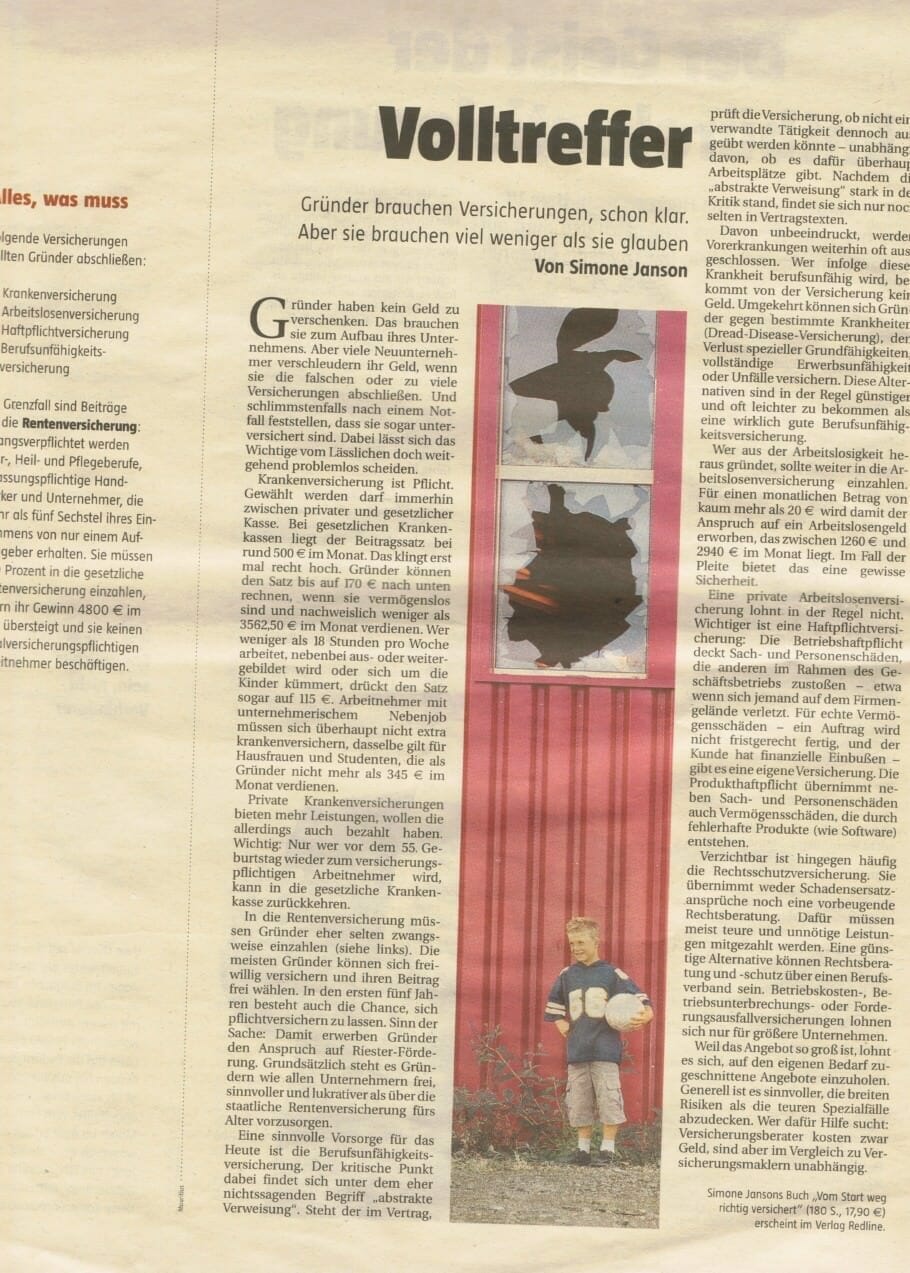For their successful, good life Information you really need: Government-funded publisher, awarded the Global Business Award as Publisher of the Year: Books, Shops, eCourses, data-driven AI-Services. Print and online publications as well as the latest technology go hand in hand - with over 20 years of experience, partners like this Federal Ministry of Education, customers like Samsung, DELL, Telekom or universities. behind it Simone Janson, German Top 10 blogger, referenced in ARD, FAZ, ZEIT, WELT, Wikipedia.
Disclosure & Copyrights: Image material created as part of a free cooperation with Shutterstock. Text originally from: “Come to stay – systemic hand luggage for successful onboarding” (2020), published by, reprinted with the kind permission of the publisher.
Onboarding & induction with success: 3 X company vs. employee perspective [+ checklists]
By Helga Bruggemann (More) • Last updated on October 18.10.2023, XNUMX • First published on 04.06.2020/XNUMX/XNUMX • So far 5687 readers, 2678 social media shares Likes & Reviews (5 / 5) • Read & write comments
Onboarding stakeholders encounter the conditions like Team- Affiliation and proficiency that all rolled into one Companys have to be balanced. How can this be done?

- Onboarding processes: Which conditions apply
- Disruptions in the familiarization phase mostly on an interpersonal level
- Balancing act between adaptation and action
- Example 1: Positioning from a company perspective
- Example 2: Positioning from the perspective of the new employee
- Example 3: The active newcomer in comparison
- Top books on the subject
- Read text as PDF
- Advice on success, goal achievement or marketing
- Book eCourse on Demand
- Skate eBook as desired
Onboarding processes: Which conditions apply
Who these conditions in onboarding, e.g. give and take, affiliation, time sequence, commitment, Performance and skill, given due attention, can develop a seismograph for fault prevention. Because most People have a feel for when systems are out of the Balance devices. On closer inspection, this feeling can be analyzed and put into words.
Knowing how things are going in this company is one thing; another is the willingness to conform to the principles. A first approximation was made during the induction period. Both sides got in touch. Boundaries of what is appropriate in cooperation and what is not were gradually defined. The danger that Regulate are not complied with due to ignorance decreases over time. In terms of content, too, the induction period was used successfully in most cases. In the rarest of cases, a new employee is technically unsuitable.
Disruptions in the familiarization phase mostly on an interpersonal level
The books on the subject (advertising)
However, disruptions in the familiarization period occur in most cases on an interpersonal level. In particular, the relationship with the direct supervisor is crucial for successful integration. The manager is an important regulatory. As a rule, he notices at an early stage if there is a need for adjustment, and he is authorized to give feedback and, if necessary, instructions. If the chemistry is right, the chance of a successful onboarding process is great.
If it is not correct, less trusting discussions take place. If the new employee does not discuss his impressions and there is no feedback, he runs the risk of not meeting expectations. Ideally, the newcomer receives regular feedback based on observed behavior or requests it. If company rules are not observed, there is a risk of exclusion if the correction is not made. According to Holger Kleve, people can only coordinate as biological and psychological units through the routine of a regular consultation. It is not possible for them to relate to one another in a direct way. People cannot transfer thoughts between themselves, cannot cognitively link from consciousness to consciousness.
Balancing act between adaptation and action
The balancing act between adaptation and active role design continues after the probationary period. How exactly this pendulum movement turns out depends on the personalities and their opportunities for good relationship design that meet in the onboarding process, as the case studies below show. Again and again it is important to find out how one's own expertise and the distanced outside view can be brought in to add value without that System disturb.
The regular comparison of self-image and external image helps, inappropriate Behavior to avoid. Regular discussions in a trusting atmosphere, in which both sides make their perceptions available, are an indicator of good work ability. In this way, the basis for a trusting cooperation is laid in the first few weeks of cooperation. This gives security to both sides. There is room to tackle the next level of integration.
Example 1: Positioning from a company perspective
Discounts for your success (advertising)!
The trial period is over and the new employee appears to have proven successful. An employee survey showed above-average results. The superior's judgment is good. It also seems to be well integrated, based on what is observable: it makes appointments with different people at the table, follows invitations to information events, and was also present at the summer party and Christmas party after the official part.
Checklist: Lack of visibility in the new job
She gladly accepted the invitation to participate in a mentoring program. The integration of the employee seems to be on the right track. The question arises as to how the bond with the company can be further expanded. In the first assessment, the employee received a very good professional rating. The development field was defined to be known beyond the boundaries within which she works. The question arises as to what possibilities there are on the company side to make their skills more visible to third parties, to offer their stages.
The newcomer does not appear enough. She has been socialized by a large, family-run company in which elegant restraint was an important part of the corporate culture. It is therefore still too reserved in the internal public arena. this will clear when answering Ask according to the visibility in the Organization, as:
- What role does it play in groups in which representatives of other departments are also present?
- What part does it take on when delegations are visiting or customer forums are held?
- How does she behave in meetings in the presence of her boss and her boss?
- How is the interaction with the supervisor?
- Is it perceived in meetings in their presence?
- What is hierarchy in general like?
How can new employees increase their visibility in the company?
The conclusion of this current position determination in this case is: The newcomer is doing a good job, but is too reluctant to interact with others, especially when dealing with the internal and external public. It can only be promoted if it becomes visible and thus part of the social reality of the organization. Those who are not noticed by other people simply do not exist.
In order to be considered for interesting special projects and to be in demand when it comes to representing the company to the outside world or at conferences Lecture To maintain, the new manager must ensure their own visibility. A mentorship is institutionalized support from the company to give it impetus in this direction. The newcomer is also expected to actively engage in Conversation bring to. She needs to show her own handwriting and be positive Resonance generate. It depends if and how fast career planning will follow the on-boarding process for this manager.
Example 2: Positioning from the perspective of the new employee
How is the situation Perspektive that of the newcomer? She now knows how the system ticks. She can assess what is expected of her and how much room for maneuver she has. She would like to explore this further and successfully advance projects. She wants to live her potential. The extent to which this is already the case can be gauged from the frequency with which her skills match the requirements to such an extent that time flies and when the work is finished she feels exhilarated.
Flow state: the ideal after changing jobs
Mihaly Csikszentmihalyi announced this optimal situation as the flow state. A visualization of the current work situation shows the degree of fit: A classification on the y-axis, which defines the level of requirements, and on the x-axis, which defines the necessary level of competence, shows the current position of the new employee at a glance: Is the classification in right upper quadrant, the current positioning is ideal
The manager could fit in with this satisfied be. She brings exactly the skills that are needed in this position to move the company forward. In terms of content, it has all the prerequisites for a good performance. As an expert, she keeps herself up to date, has political skills and a good sense of collegial leadership. In a social system, this individual fit alone is no guarantee for sustainability Success. The manager still lacks an informal network of relationships, such as she had built up with her previous employer.
Checklist: Create a safety net through mentoring
How often, after years of service, did she always come to a point where she didn't know what to do. The strategic reorientation, the competitive environment, the prioritization of projects, all of this was constantly in flux. At that time she only had to pick up the phone and was able to talk about informal things ways get advice quickly. The new manager cannot have this safety net after having been with the company for such a short time. The company therefore offered her a mentoring program as support.
A manager from another department, two hierarchical levels above her, became her sparring partner. The exchange with her was very helpful in classifying what to do, but also what to refrain from doing. Her mentor advised her to network more informally. There were questions about how to do this:
- Is there a corporate network that she could enter?
- Are there internal company events that are carried out across departments?
- For which overarching projects could she throw her hat in the ring to think outside the box and make contacts?
What is not communicated does not exist socially
Another point that kept coming up was her role, which she played primarily. In the exchange with the mentor, she realized that she had many more opportunities than she used. It took an external impetus to consciously leave the expert role again and again and to take on the driving role that others perceive. She needed a stage. Fritz Simon compares the exposed role visible to all with that of an artist, the role of the expert working in the background with a housewife. Artists on stage are noticed when they are doing something. You get positive Feedbackwhen they play.
»Housewifery activities« are conspicuous when they are not done. You receive negative Return message. Those who are aware of this distinction may weigh differently whether they accept an offer to show themselves or whether they prefer to keep a low profile. Especially in official situations, where visibility was greatest due to the presence of hierarchy, the employee took as many opportunities as possible to show herself after reflecting on her visibility in the company. She deliberately took the lead. Their skill was visible in the organization. From a systems theory point of view, she had created social reality by doing something to awareness to attract. What not in the Communication comes does not exist socially. Because of this changed behavior, she became better known and was able to do her informal in a short time Network Remove.
Example 3: The active newcomer in comparison
The situation is different for a newcomer who, due to his personality and character, tends to take the lead. Due to his previous managerial position in his own company, he is used to acting autonomously and quickly decide. This manager quickly became visible in the organization. Reassurance from superiors was not common in the corporate culture from which he comes. Accordingly, he is conspicuous by the many quick decisions he makes regardless of the context.
Become known about the limits of his area of responsibility
This quickly makes him known beyond the limits of his area of responsibility, since his decisions often affect the areas of competence of others. He takes the lead and takes a lot of space. Depending on the situation, this can be appropriate or critical leadership behavior. When it comes to its employees Orientation to give, trend-setting offensive management behavior is expedient. However, there are also situations in which a role other than that of driver would be advisable. Especially in the presence of representatives from higher hierarchical levels, customers and experts from other areas, it would be advantageous to exploit the variety of roles.
If a competent manager is responsible for and drives a process forward, this role does not need to be repeated a second time. Otherwise, a competitive situation would quickly arise. A sideshow would be opened. Energy flow away on an interpersonal level, which would be needed on the content level for the achievement of goals. Based on their assessment, this employee will receive a Coaching offered to become aware of his behavioral patterns.
Use behavior in a context-sensitive manner
This newcomer proves itself and has a successful Career ahead of him, provided he learns to make his behavior more context sensitive. He is expected to step on the gas or hold back, depending on the situation. Of the assets, its behavior in Future Being able to vary more will depend on how his career at this company goes. Like the painter's canvas, the actor's stage, the poet's paper, or the composer's sheet music, organization is for management.
The company that the newcomer has joined offers many advantages compared to his previous position, in which he was responsible for everything himself as an entrepreneur. At that time, for each new question, one had to be Solution being found. In the rarest of cases, there were already defined processes that he could fall back on. That took a lot of time, which he rarely had in sufficient quantity. In this company, the situation is different. There is a large database that he can fall back on. On the intranet, he has access to the organization's documented empirical knowledge.
Create networks
Accessing this database saves time. He also has many more colleagues here whom he can approach if necessary. He's not afraid to put the phone in the Hand or to make an appointment to get advice, even if he only knows the people from hearsay. In a short time he was able to make so many helpful contacts. What he perceives as making work easier on the one hand, he also perceives as a restriction on the other. He finds it difficult to adhere to defined processes when a short informal discussion with another department would quickly bring about a solution. It is also not reasonable for him to follow a person whose experiences he has the impression cannot be transferred to this problem.
He has to really control himself if he has the impression that the person he is talking to is less competently as he. He then often seizes the scepter, even if his interlocutor is hierarchically above him. He knows he should hold back more. However, if from his point of view wrong decisions are imminent, his behavior is like a reflex. He just has to take countermeasures. Not only from his point of view, but also in the interests of the company useful and therefore be legitimate. Taking a clear position and taking the lead is a solution strategy with which he has been successful so far.
Checklist: How coaching processes help
During a development meeting at the end of the probationary period, coaching was suggested to him. Although his professional performance was viewed positively, he was perceived by superiors and managers in other areas as someone who was not so good to deal with light is to cooperate. Although he had already noticed irritated reactions on the part of some of the interlocutors in some situations, he didn't know what he could do differently.
The coaching helped him with precisely this question. He was made aware of the situations in which he perceived irritation from others. It turned out that these mainly occurred in meetings and presentations when different departments and superordinates were present. He learned not only to prepare these meetings professionally, but also to take greater account of the group dynamic level. He became aware of the context by asking questions such as:
- Who is inviting?
- Who is responsible for achieving the goals?
- What role am I invited to?
- When will this be a good event?
- Who has what interests?
Being clearer on these points helped him adjust his behavior to the situation without feeling like he was bending.
Top books on the subject
Read text as PDF
Acquire this text as a PDF (only for own use without passing it on according to Terms and conditions): Please send us one after purchase eMail with the desired title supportberufebilder.de, we will then send the PDF to you immediately. You can also purchase text series.
4,99€Buy
Advice on success, goal achievement or marketing
Do you have questions about careers, Recruiting, personal development or increasing reach? Our AI consultant will help you for 5 euros a month – free for book buyers. We offer special ones for other topics IT services
5,00€ / per month Book
Book eCourse on Demand
Up to 30 lessons with 4 learning tasks each + final lesson as a PDF download. Please send us one after purchase eMail with the desired title supportberufebilder.de. Alternatively, we would be happy to put your course together for you or offer you a personal, regular one eMail-Course - all further information!
29,99€Buy
Skate eBook as desired
If our store does not offer you your desired topic: We will be happy to put together a book according to your wishes and deliver it in a format of yours Choice. Please sign us after purchase supportberufebilder.de
79,99€Buy
Here writes for you
Helga Brüggemann heads the systemic consultancy in Düsseldorf and is also a founding member of a start-up team in Zurich. Her specialty is multidimensional organizational development. She works in systemic consulting (SG), group dynamics and large group moderation (CPF) as well as lecturer at the University of Witten / Herdecke. All texts by Helga Brüggemann.



















Post a Comment